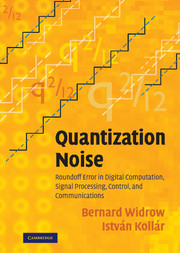 Quantization Noise
Quantization Noise Book contents
- Frontmatter
- Contents
- Preface
- Acknowledgments
- Glossary of Symbols
- Acronyms and Abbreviations
- Part I Background
- Part II Uniform Quantization
- Part III Floating–Point Quantization
- Part IV Quantization in Signal Processing, Feedback Control, and Computations
- Part V Applications of Quantization Noise Theory
- Part VI Quantization of System Parameters
- APPENDICES
- A Perfectly Bandlimited Characteristic Functions
- B General Expressions of the Moments of the Quantizer Output, and of the Errors of Sheppard's Corrections
- C Derivatives of the Sinc Function
- D Proofs of Quantizing Theorems III and IV
- E Limits of Applicability of the Theory — Caveat Reader
- F Some Properties of the Gaussian PDF and CF
- G Quantization of a Sinusoidal Input
- H Application of the Methods of Appendix G to Distributions other than Sinusoidal
- I A Few Properties of Selected Distributions
- J Digital Dither
- K Roundoff Noise in Scientific Computations
- L Simulating Arbitrary–Precision Fixed–Point and Floating–Point Roundoff in Matlab
- M The First Paper on Sampling–Related Quantization Theory
- Bibliography
- Index
G - Quantization of a Sinusoidal Input
from APPENDICES
Published online by Cambridge University Press: 06 July 2010
- Frontmatter
- Contents
- Preface
- Acknowledgments
- Glossary of Symbols
- Acronyms and Abbreviations
- Part I Background
- Part II Uniform Quantization
- Part III Floating–Point Quantization
- Part IV Quantization in Signal Processing, Feedback Control, and Computations
- Part V Applications of Quantization Noise Theory
- Part VI Quantization of System Parameters
- APPENDICES
- A Perfectly Bandlimited Characteristic Functions
- B General Expressions of the Moments of the Quantizer Output, and of the Errors of Sheppard's Corrections
- C Derivatives of the Sinc Function
- D Proofs of Quantizing Theorems III and IV
- E Limits of Applicability of the Theory — Caveat Reader
- F Some Properties of the Gaussian PDF and CF
- G Quantization of a Sinusoidal Input
- H Application of the Methods of Appendix G to Distributions other than Sinusoidal
- I A Few Properties of Selected Distributions
- J Digital Dither
- K Roundoff Noise in Scientific Computations
- L Simulating Arbitrary–Precision Fixed–Point and Floating–Point Roundoff in Matlab
- M The First Paper on Sampling–Related Quantization Theory
- Bibliography
- Index
Summary
The extremely fast rolloff of the characteristic function of Gaussian variables provides nearly perfect fulfillment of the quantization theorems under most circumstances, and allows easy approximation of the errors in Sheppard's corrections by the first terms of their series expression. However, for most other distributions, this is not the case.
As an example, let us study the behavior of the residual error of Sheppard's first correction in the case of a sinusoidal quantizer input of amplitude A.
Plots of the error are shown in Fig. G.1.
It can be observed that neither of the functions is smooth, that is, a high–order Fourier series is necessary for properly representing the residual error in Sheppard's first correction, R1(A, μ) with sufficient accuracy. The maxima and minima of R1(A, μ) obtained for each value of A by changing μ, exhibits oscillatory behavior. For some values of A, for example as A ≈ 1.43q or A ≈ 1.93q (marked by vertical dotted lines in Fig. G.1(b)), the residual error of Sheppard's correction remains quite small for any value of the mean, but the limits of the error jump apart rapidly for values of A even close to these. A conservative upper bound of the error is therefore as high as the peaks in Fig. G.1(b). One could use the envelope of the error function for this purpose.
- Type
- Chapter
- Information
- Quantization NoiseRoundoff Error in Digital Computation, Signal Processing, Control, and Communications, pp. 637 - 662Publisher: Cambridge University PressPrint publication year: 2008
